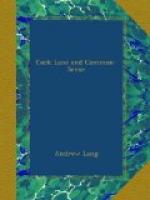SCRYING OR CRYSTAL-GAZING
Revival of crystal-gazing. Antiquity of the practice. Its general harmlessness. Superstitious explanations. Crystal-gazing and ‘illusions hypnagogiques’. Visualisers. Poetic vision. Ancient and savage practices analogous to crystal-gazing. New Zealand. North America. Egypt. Sir Walter’s interest in the subject. Mr. Kinglake. Greek examples. Dr. Dee. Miss X. Another modern instance. Successes and failures. Revival of lost memories. Possible thought-transference. Inferences from antiquity and diffusion of practice. Based on actual experience. Anecdotes of Dr. Gregory. Children as visionaries. Not to be encouraged.
The practice of ‘scrying,’ ‘peeping,’ or ‘crystal-gazing,’ has been revived in recent years, and is, perhaps, the only ‘occult’ diversion which may be free from psychological or physical risk, and which it is easy not to mix with superstition. The antiquity and world-wide diffusion of scrying, in one form or other, interests the student of human nature. Meanwhile the comparatively few persons who can see pictures in a clear depth, may be as innocently employed while so doing, as if they were watching the clouds, or the embers. ‘May be,’ one must say, for crystal-seers are very apt to fall back on our old friend, the animistic hypothesis, and to explain what they see, or fancy they see, by the theory that ‘spirits’ are at the bottom of it all. In Mrs. de Morgan’s work From Matter to Spirit, suggestions of this kind are not absent: ’As an explanation of crystal-seeing, a spiritual drawing was once made, representing a spirit directing on the crystal a stream of influence,’ and so forth. Mrs. de Morgan herself seemed rather to hold that the act of staring at a crystal mesmerises the observer. The person who looks at it often becomes sleepy. ’Sometimes the eyes close, at other times tears flow.’ People who become sleepy, or cry, or get hypnotised, will probably consult their own health and comfort by leaving crystal balls alone.




